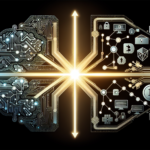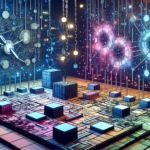Understanding Quantum Mechanics and Its Implications
What is Quantum Mechanics?
Quantum mechanics is a branch of physics that deals with the behavior of particles at the smallest scales, such as atoms and subatomic particles. Unlike classical mechanics, which relies on deterministic laws, quantum mechanics introduces concepts such as superposition, entanglement, and uncertainty. These principles challenge our traditional understanding of how matter and energy interact and have led to revolutionary advancements in technology, including quantum computing.
The Role of Quantum Mechanics in Technology
The implications of quantum mechanics extend far beyond theoretical physics. Technologies such as lasers, semiconductors, and magnetic resonance imaging (MRI) all stem from the principles of quantum mechanics. Furthermore, the advent of quantum computing is set to revolutionize various fields, from cryptography to drug discovery. By harnessing quantum superposition and entanglement, quantum computers can process information at speeds unattainable by classical computers.
Distributed Ledger Technologies Explained
What is a Distributed Ledger Technology (DLT)?
Distributed ledger technologies are systems that allow the sharing and synchronization of data across multiple locations. Unlike traditional databases, which typically rely on a central authority, DLT operates on a peer-to-peer network. This decentralized approach enhances security, transparency, and immutability, making DLT particularly popular in financial services through applications like blockchain.
Applications of DLT
The most recognized application of DLT is Bitcoin, but its potential extends far beyond cryptocurrencies. Various sectors, including supply chain management, healthcare, and governance, are exploring DLT for its ability to provide real-time data sharing and reduce fraud. Smart contracts, powered by DLT, automate and streamline processes, reducing the need for intermediaries.
The Intersection of Quantum Mechanics and DLT
Why Connect Quantum Mechanics and DLT?
As quantum computing progresses, there’s a growing realization of its potential impact on DLT. Quantum computers could solve complex problems in seconds, while classical computers might take years. This capability raises concerns regarding the security of traditional cryptographic methods employed in DLT. Bridging quantum mechanics and DLT is crucial to ensuring the integrity and safety of decentralized systems in a future dominated by quantum computing.
Challenges in Integrating Quantum Mechanics with DLT
While the intersection of quantum mechanics and DLT is promising, it is also fraught with challenges. Classical cryptographic techniques, such as RSA and ECC (Elliptic Curve Cryptography), could become vulnerable to quantum attacks. Quantum computers could quickly factor large numbers or solve discrete logarithm problems, undermining the security that underpins many blockchain networks.
Quantum Threats to Cryptography
The most significant threat posed by quantum computing to DLT is the potential for quantum algorithms to break conventional cryptography. Shor’s algorithm, for example, can efficiently factorize large integers, which would render widely-used encryption methods obsolete. The urgency to develop quantum-resistant algorithms is paramount for securing DLT against such vulnerabilities.
Scalability and Performance Issues
As DLT grows, scalability becomes a pressing issue. Adding quantum mechanics into the mix could exacerbate these challenges. Quantum algorithms may require new types of data structures and may not integrate seamlessly with existing blockchain frameworks. The implementation of quantum-resistant solutions must also ensure that system performance does not suffer.
Standards and Interoperability
Creating standards for a quantum-ready DLT ecosystem is also critical. Lack of interoperability between different DLT systems can hinder the widespread adoption of quantum innovations. As research moves forward, developing protocols that accommodate both classical and quantum systems will be essential for the seamless operation of future networks.
Potential Solutions for Bridging the Gap
Quantum-Resistant Cryptography
To prepare for the quantum future, researchers are actively developing quantum-resistant cryptographic algorithms. These algorithms aim to withstand the potential threats posed by quantum computing. Various techniques, such as lattice-based cryptography and hash-based signatures, are gaining traction as viable alternatives.
Quantum Key Distribution (QKD)
Quantum Key Distribution (QKD) is another promising approach. QKD uses the principles of quantum mechanics to create secure communication channels. By leveraging the properties of quantum entanglement, QKD ensures that any attempt to eavesdrop on a communication would be detectable. This technology could significantly enhance the security of distributed ledger systems.
Implementation of Hybrid Systems
Adopting hybrid systems that integrate both classical and quantum technologies could be a practical solution during the transition period. Such systems could use existing DLT frameworks while layering in quantum-resistant features. This adaptability would allow organizations to upgrade their security measures without completely overhauling their infrastructure.
Collaborations and Research Initiatives
Academic and Industry Collaborations
Bridging the gap between quantum mechanics and DLT will require collaboration across disciplines. Academic institutions are partnering with industry leaders to explore innovative applications of quantum technologies in DLT. Multidisciplinary teams comprising physicists, computer scientists, and cryptographers can drive forward-thinking research.
Government and Regulation Support
Government agencies can play an essential role in fostering the development of quantum-safe technologies. Encouraging research funding, establishing regulations for quantum technologies, and promoting standards can help secure the future of DLT in the face of quantum challenges.
Conclusion
In summary, bridging the gap between quantum mechanics and distributed ledger technologies is a significant step toward ensuring the longevity and security of decentralized networks. By investing in research, collaboration, and innovative solutions, industries can prepare for the quantum future while leveraging the transformative potential of both fields. The journey is complex, but with the right approaches, a robust and secure ecosystem can emerge.








